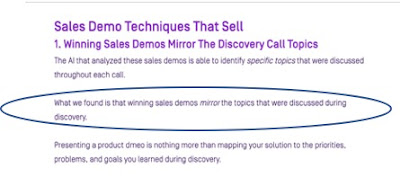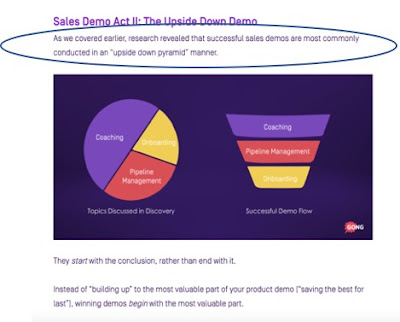-->
Here
are seven demo success factors that lead to closed business. We’ll discuss each of these briefly and, for
current Great Demo! practitioners, we’ll note where they align with Great Demo!
principles.
The
fine folks at Gong.io analyzed thousands millions of demos to uncover
these seven success factors:
1. Pre-Demo
Discovery
2. A crisp
review of the Customer’s Situation
3. Do the Last
Thing First
4. Inverted
Pyramid
5. Peel Back the
Layers
6. Peel Back the
Layers (reprised)
7. Transition
Vision
A Bit of
Background
In
their original study, the Gong
team analyzed 67,149 demo recordings and matched the results to closed or
progressed business. More recent studies now include data from over 3 million demos across a broad range
of B-to-B software companies, offerings and verticals – that’s a LOT of data!
Their
analysis identified four “acts” in the most successful demos:
Act 1: The Contextual
Overview
Act 2: The Upside Down Demo
Act 3: Accelerated
Interaction
Act 4: The Wrap Up
Let’s examine each in order, along the
associated key success factors.
The “[GD]” paragraphs provide notes
for existing Great Demo! practitioners on how the success factors map to Great
Demo! principles (which also represent terrific starting points for those who
are interested in learning or exploring the Great Demo! methodology).
Pre-Gong Act
1: Doing Discovery
Gong found that the most successful demos focused on
what was learned in substantive Discovery conversations – not “on-the-fly”
Discovery, but effective pre-demo interactions:
Key Success Factor Number 1
Presales and sales teams need to actually execute
Discovery (not just qualification or “BANT”) to uncover the situational
information needed to deliver successful demos.
This is absolutely key!
The Gong studies further provide a simple guideline
– map your demo to what you learned in Discovery. Sounds obvious, but you need to do
sufficient Discovery in order to accomplish this.
And not surprisingly, the studies also suggest that
showing capabilities that were not discussed in Discovery puts you at
risk of “buying it back” and making your demo look too complicated.
Sadly, many sales and presales folks believe
they do a good job doing Discovery – when they actually do not (or could
certainly do much better). This is an important
opportunity for improvement – and represents a fabulous opportunity to
differentiate from competition!
[GD] In Great Demo! Workshops, we
teach what specific Discovery information is needed to enable a vendor
to prepare and deliver a highly successful demo – and how to execute
Discovery to achieve this.
Gong Act
1: The Contextual Overview
Most traditional, comparatively unsuccessful
demos consume the first Act with corporate overviews, logo slides, product and
architecture presentations – often referred to as “first-call decks”.
Conversely, the Gong studies showed that the most
successful demos began with a “contextual overview” that ran no longer than two minutes. No corporate overview. No product intro. No architecture slides. And especially no review of “our customers’
logos”. Just a crisp review of the
customer’s specific situation – no longer than two minutes.
Key Success Factor Number 2
The Gong studies confirm what we logically
already realize (but often fail to put into practice), that the demo meeting should
be all about the customer. Unfortunately,
far too many demo meetings start with corporate overview presentations – often
riddled with inappropriate logo slides – followed by product and related
presentations.
All of these are all about the vendor. That’s the problem!
The most successful demos started with a
review that is customer focused.
In the best cases, these demos started with a summary of what was
learned in Discovery – that’s a critical success factor and another major opportunity
to differentiate.
[GD] In Great Demo! we use a Situation Slide to begin the demo,
aligning delightfully with the findings.
Situation Slides concisely summarize the vendor’s understanding of the
customer’s situation – their overarching goals, their current situation, pain
and problems, the specific capabilities the customer is looking for, the value
desired, and the required timeline. And
the typical time to present a Situation Slide is – you guessed it – about 1-2
minutes.
Gong Act
2: The Upside Down Demo
Traditional demos typically follow a
seemingly logical linear pathway, from set-up, through a series of workflows,
to finally getting to end results and reporting – a “Day-in-the-Life” demo is
the classic form.
The Gong data shows that this is an unsuccessful approach. Why?
- High ranking people often leave the meeting before the
vendor gets to the “best stuff”.
- Those who remain find their brains have turned to mush
after the 20, 30, 40 (or more!) minutes of talk-and-mouse, mouse-and-talk…
- Vendors often run out
of time before they get to the
“best stuff”…!
Key Success Factor Number 3
The Gong results clearly show that beginning
Act 2 with the most valuable part of your offering yields the highest demo
success rates. As the Gong folks said,
“They start with the conclusion…”:
[GD]
Hey – note my blue highlights on the Gong slide – and I didn’t even know
this study was underway until it was published…! In Great Demo! we teach how to “Do the Last
Thing First” – a critical success factor specifically validated in the studies.
Key Success Factor Number 4
But wait, there’s more…! Gong observed:
Gong’s findings showed that demos that
followed stepwise workflows failed to incorporate this key success factor. Further, the study noted that demos that
mapped the order of presentation to the relative importance of capabilities
were the most successful:
- Most important topics first
- Next most important
- Less important
- Least important
An additional bonus of this technique is that
you are at risk of sacrificing the least important topics if you run out
of time.
[GD] This maps directly to Great Demo! methodology – and
specifically to the use of the “Inverted Pyramid” approach for demos (borrowed
from newspapers and journalism). This
technique is a core Great Demo! concept and teams learn how to put it into
practice in our Workshops.
Gong Act
3: Accelerated Interaction
In spite of vendors saying, “Please ask
questions along the way – we want this to be very interactive…” most
demonstrators talk and click for 6, 8, or 10 minutes (or longer!) before
checking-in and asking the inevitable “Any questions so far?”
Sadly, “Nope, we’re good…” is the response
often heard from customers – or the sound of crickets in an empty room (chirp!
chirp! chirp!)…
This is not
a good sign! Real interactivity
is key. Gong found the following results:
“We didn’t find a single demo that lead to a closed deal in the
analysis that involved more than 76 seconds of uninterrupted pitching.”
An average of 76 seconds. Wow.
That should cause some vendors some concern…!
Key Success Factor Number 5
The most successful demos encouraged a
two-way, bi-directional conversation between the customer and the
vendor.
Intriguingly, traditional demos “pre-answer”
most of the questions that audiences might ask – eliminating the
possibility of a conversation. The Gong
results show that vendors should have the answers to customer questions ready –
but hold them “behind your back” in a virtual sense. Let the customers ask the questions –
this is what enables the conversation to take place.
You will know your demo is going perfectly
when the customer is asking the questions you expect them to ask at that
point!
[GD] In Great Demo! we teach how to encourage and enable a conversation to take place, yielding the
frequent “speaker switches” that Gong’s studies show result in more successful
demos. We call it “Peeling Back the
Layers” – in accord with each individual customer’s depth and level of
interest.
Key Success Factor Number 6
The Gong studies found that the most
successful vendor presenters enjoyed receiving 28% more questions from
their customers than their less successful peers:
For example, most executives
only want the 30,000 foot (9,114 meter) view; middle managers typically want to
go a bit deeper; staffers want the workflow details; system administrators
desire a different set of specifics.
Gong found that:
[GD] Hey look – they referenced Great
Demo! again…!
Peel Back the Layers – and explore as deeply
as the individual customer players have interest.
In Great Demo! training, participants
practice this critical skill in coached role-play exercises. We help them learn how to break up their
traditional monolithic talk tracks into bite-size components (peeling back
layers of the onion, to continue the analogy…).
Additionally, Great Demo! Workshop
participants learn exactly how deep to go to satisfy the various members of the
customer team – and to “stop selling when the customer is ready to buy”.
After all, what happens if you peel an onion
too far? You cry…!
Gong Act
4: The Wrap Up
Gong identifies the final part of the demo as
the Wrap Up and comments that this is the most appropriate time for pricing and
next steps discussions. Makes sense:
However, the concept of “next steps” is broad
and is an excellent opportunity to differentiate. In traditional demos, vendors focus on “next
steps” that proceed solely to the sale.
This is adequate behavior, but not exceptional.
Key Success Factor Number 7
Truly great sales teams interpret part
of “next steps” to include a discussion of how the customer can move from their
current painful state, through go-live and deployment, all the way to the point
in time where the customer begins to get tangible value from the offering – a
Value Realization Event.
This establishes a “Transition Vision” in the
customer’s mind – and the vendor that includes this discussion in the Wrap Up
will be in a competitively advantageous position vs. traditional vendors.
[GD] We teach this process in Great Demo! Workshops and
identify (at least) two key entities:
1.
A Critical Date that drives the
customer’s go-live date, and
2.
A Value Realization Event that
defines an early win or small ROI, post go-live.
This demonstrates to the customer that the
vendor is not just interested in getting the order, it also shows that
the vendor has a genuine and tangible interest in the customer’s success.
Four “Acts” – Seven Key Success Factors
The Gong studies show conclusively
what specific tactics result in successful demos – and progressed
business. If you or your team are
ignoring these findings, you are likely at a disadvantage compared to vendors that
adopt and apply these practices.
Fundamentally, traditional demos are less
successful than their rephrased counterparts.
Perhaps it is time to embrace change…!
[GD] It’s one
thing to know in your heart that an approach is particularly effective – it’s
quite another to have a methodology validated by millions of data
points! If you are already a Great Demo!
practitioner – congratulations – this article may help you convince your
colleagues to join your approach to preparing and delivering demos.
If you are not (yet) applying Great
Demo! principles – well, maybe it is time to explore…!
Copyright © 2017-2020 The Second Derivative –
All Rights Reserved other than the Gong slides – many thanks to Gong for these
studies!








No comments:
Post a Comment